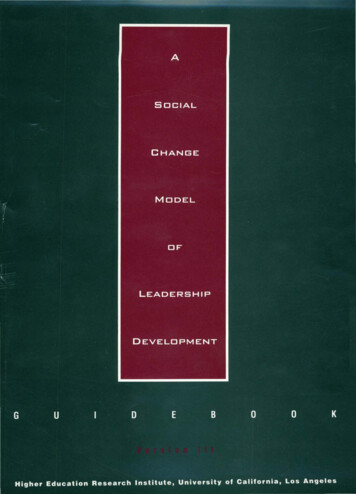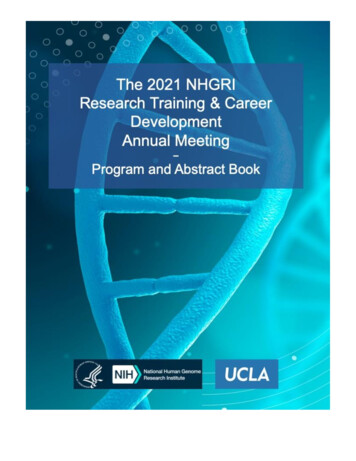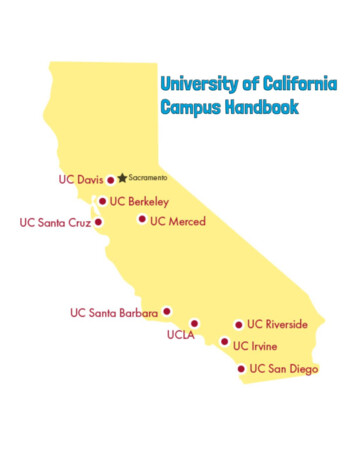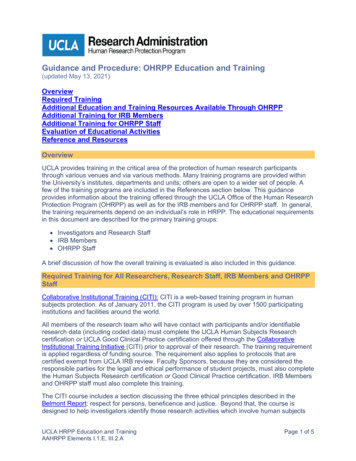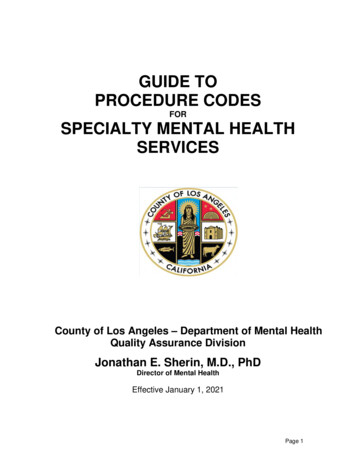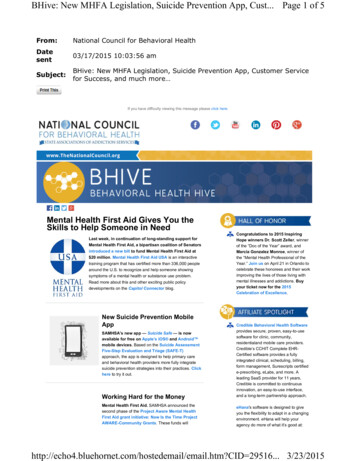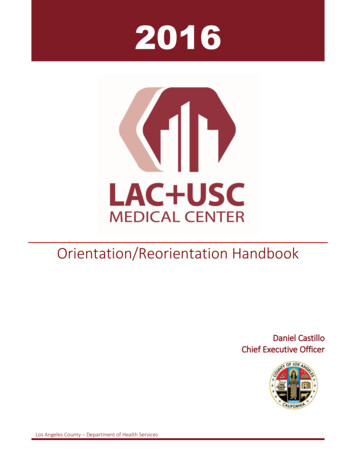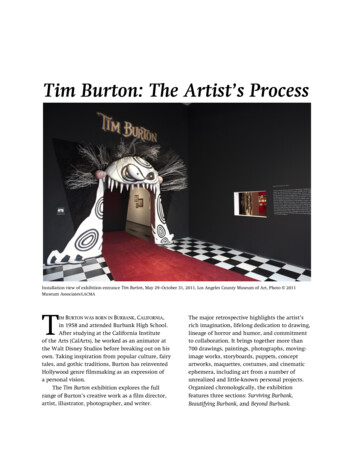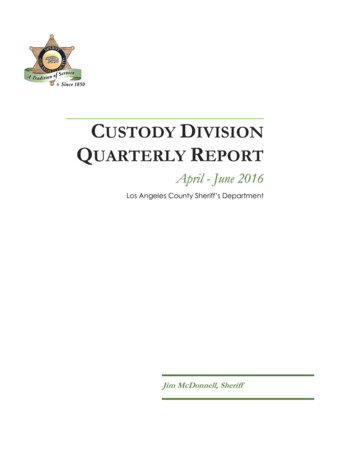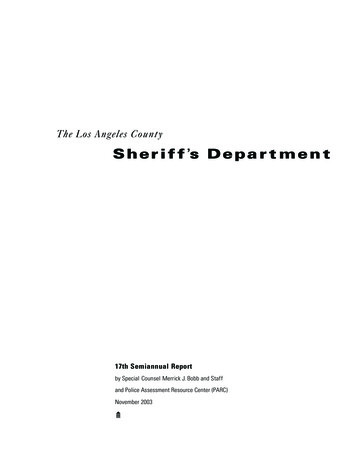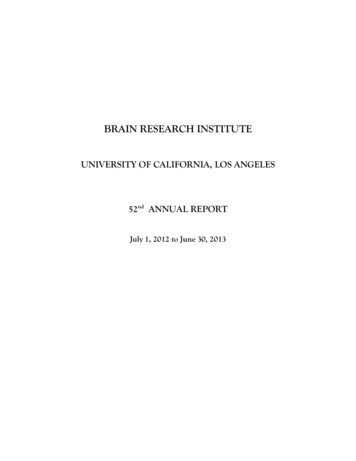
Transcription
BRAIN RESEARCH INSTITUTEUNIVERSITY OF CALIFORNIA, LOS ANGELES52nd ANNUAL REPORTJuly 1, 2012 to June 30, 2013
MISSIONThe Brain Research Institute’s mission is: to increase understanding of how the brain works, how it develops, and how it responds to experience,injury and disease;to help make UCLA the preeminent center for translating basic knowledge into medical interventionsand new technologies; andto promote neuroscience education at all levels.To execute this mission, the BRI functions explicitly as the interdisciplinary and non-departmental voice of thebasic neuroscience community. The BRI’s strategic goals are: to invigorate research programs and to nurture novel collaborations that bring together investigatorsfrom complementary fields;to stimulate the translation of basic knowledge into therapies and cures for diseases and injuries of thenervous system;to recruit outstanding faculty, postdoctoral fellows and graduate students;to strengthen existing educational programs by fostering the integration of insights from basicneuroscience, cell and molecular biology, cognitive science, engineering and clinical neuroscience; andto extend educational outreach programs about the brain into the community.HISTORYThe Brain Research Institute is an Organized Research Unit (O.R.U.) that fosters interdisciplinary researchand education within the UCLA neuroscience community. At the present time it includes 343 members; 277 fullmembers who are active faculty members, 57 emeritus members, and 9 corresponding members, representing 27academic departments throughout the campus.The generosity of the Gonda family made possible the newest home of the Brain Research Institute, theGonda (Goldschmied) Neuroscience and Genetics Research Center. A formal dedication of this specially designedresearch center was held on December 15, 1998. The first three floors of this building are designated specifically forthe support of neuroscience research and education.Organization of the Institute began in the early 1950s. Under the leadership of Dr. H. W. Magoun,members of many departments with prominent interests in nervous system research were encouraged to developcloser relationships so they might broaden the scope of their investigative activities and extend the effectiveness oftheir educational efforts.A formal proposal was written and reviewed, and late in 1959, Institute status was assigned by the Universityof California. Concurrently, plans were completed to erect a building to house the research projects. In 1958,construction of a structure containing 76,000 square feet of space began. Occupancy of the building started inMarch of 1961, and the official opening of the Brain Research Institute was held on October 14 and 15, 1961. Dr.John D. French served as Director during the period 1961 to 1976. He was followed by Dr. Carmine D. Clemente,who served from 1976 to 1987. Dr. Arnold B. Scheibel served as Acting Director from 1987-1990, and as Directoruntil June 1995. Dr. Allan J. Tobin served as Director from July 1995 through December 2003. For the year 2004,Dr. Christopher Evans, Associate Director for Research, and Dr. Michael Levine, Associate Director for Education,served as Interim Co-Directors. In December 2004, Dr. Christopher Evans was appointed as Director of the BRI.
Brain Research InstituteSummary of Activities 2012-2013Number of Members343Number of Member PublicationsCollaborative Publications between two or more BRImembersPredoctoral Students under Supervision of BRI Members1515Postdoctoral Students under Supervision of BRI Members317Total Funding Administered through the BRI Fiscal Office(BRI Training Grants) 1.97 million750332Annual Lectures and Prizes:H.W. Magoun Lecture presented by V. Reggie Edgerton.Eva Mary Kavan Prize for Excellence in Research on the Brain recipient: Sangmok Kim.Charles Sawyer Distinguished Lecture presented by Melissa Hines.Samuel Eiduson Student Lecture presented by Jesse Brown.The Arnold Scheibel Distinguished Postdoctoral Fellow in Neuroscience Lecture presented by Paul Mathews.Guest LecturesThe Joint Seminars in Neuroscience sponsored twenty--eight guest lectures this year. The Joint Seminars in Neuroscienceare sponsored by the Brain Research Institute, the Semel Institute for Neuroscience & Human Behavior and the David GeffenSchool of Medicine at UCLA. In addition, the Brain Research Institute sponsored or co-sponsored 98 special guestlectures this year. For a complete list of the speakers and the title of their presentations, please see “Joint Seminars inNeuroscience” and “Special Lectures” within the “Instructional Activity” section of this report.Poster SessionThe BRI Neuroscience Poster Session, featuring the research of all UCLA neuroscientists, includingpredoctoral students and postdoctoral fellows, was initiated in 1989. This year, the 24th Annual Neuroscience PosterSession was held on December 4, 2012. The Poster Session was attended by well over 300 neuroscientists comprised ofgraduate students, postdoctoral fellows, and faculty members that represent a multitude of departments on campus. Over150 posters were presented, many of which had been presented at the 42nd Annual Meeting of the Society for Neuroscience.The guest speaker this year was J. Anthony Movshon, Ph.D. from the Center for Neural Science, New York University, NewYork. He presented, “Cortical Mechanisms of Visual Perception,” to a standing-room-only crowd. This yearly postersession represents continuing efforts to educate investigators about state-of-the-art neuroscience research beingconducted at UCLA.Special Conferences Sponsored or Co-Sponsored by the Brain Research InstituteTo view program schedules, please see “Special Conferences,” listed in the “Instructional Activity” section ofthis report.The UCLA Integrative Center for Neurogenetics Inaugural SymposiumThe Inaugural Symposium of the UCLA Integrative Center for Neurogenetics was held on February 21, 2013.The UCLA Integrative Center for Neurogenetics (ICNG) focuses on discovering the genetic basis of majorpsychiatric and neurological disorders, and genetically dissecting additional traits that will shed light on thedevelopment, function, or degeneration of the central nervous system. Lack of understanding of the causes ofbrain diseases limits our capacity to develop better treatments and for prevention. We now have the research tools
necessary to identify and characterize the specific genetic variations that predispose to brain disorders or that areassociated with important nervous system traits in a wide range of model organisms.The 11th Annual Center for Neurobiology of Stress Basic and Translational Science SymposiumThe 11th Annual Center for Neurobiology of Stress Basic and Translational Science Symposium, “SystemsBiological Approaches to Gut-Brain Interactions in Health and Disease- From Molecular to Social Networks,” washeld on April 26, 2013.The symposium was sponsored by the UCLA Brain Research Institute, the UCLA Division of DigestiveDiseases, the VA Greater Los Angeles Healthcare System/Brentwood Biomedical Research Institute, the Gail andGerald Oppenheimer Family Foundation and the Morris A. Hazan Family Foundation. Additional informationabout the Center can be found on the Center’s website: www.uclacns.org.Neural -Immune Interactions in Neurodegenerative Diseases: Innate and Adaptive Neuroprotective andRegenerative MechanismsThe 3rd UCLA Immunology in Neuroscience Mini-Symposium/Poster Gala, “Neural -Immune Interactionsin Neurodegenerative Diseases: Innate and Adaptive Neuroprotective and Regenerative Mechanisms,” was held onMay 7, 2013. The program featured four invited speakers who have made major contributions to theunderstanding of how neuroinflammatory responses potentiate or restrict the pathologies of neurodegenerativediseases and/or contribute to their repair. To provide an opportunity for informal scientific exchange, a postersession was held immediately following the mini-symposium.The 7th Annual Neural Microcircuits Training Program Symposium, “Dynamics of Neural Microcircuits”The 7th Annual Neural Microcircuits Training Program Symposium, “Dynamics of Neural Microcircuits” washeld on May 9, 2013.20th Annual Joint Symposium on Neural ComputationIn 1994, the Institute for Neural Computation at the University of California, San Diego hosted the first JointSymposium on Neural Computation with the California Institute of Technology in Pasadena. This Symposiumbrought together students and faculty for a day of short presentations. Since then, this Symposium has rotatedbetween San Diego, Caltech, UCI, UCLA, USC and UCR. This year, the 20th Annual Joint Symposium onNeural Computation was held at the California Institute of Technology on June 1, 2013.The Integrative Center for Learning and Memory12th Annual Southern California Learning and Memory SymposiumThe Twelfth Annual Southern California Learning & Memory Symposium was held on June 3, 2013. Thissymposium is a yearly meeting primarily for Southern California laboratories interested in plasticity and learning.This year’s annual symposium was supported by the Brain Research Institute, and the Clinical and TranslationalScience Institute.Prion-Like Pathogenesis in Neurodegenerative DiseasesThe Prion-Like Pathogenesis in Neurodegenerative Diseases symposium was held on June 13, 2013. Thissymposium was sponsored by the CHDI Foundation, the UCLA Department of Neurology, and the UCLA BrainResearch Institute.Carol Moss Spivak Cell Imaging FacilityIn March 2008, the BRI Cell Imaging Facility moved to the California Nanosystems Institute (CNSI) to joinwith the CNSI Advanced Light Microscopy Facility. The joined facility has since served over 1400 usersrepresenting over 250 labs at UCLA, LABioMed, Harbor-UCLA and Cedars Sinai Health Center as well as severalindustry laboratories (e.g. Nestlé, NanoH2O, Sonendo Inc., Agensys Inc.). The facility houses five Leica spectralconfocal microscopes, three of which have multiphoton laser scanning ability. The facility now has a Spinning
Disk Confocal microscope, a Laser Microdissection System and will soon have a TIRF (Total Internal ReFlectance)microscope online. Additional techniques now available include: FRET (fluorescence resonance energy transfer)FLIM (fluorescence lifetime imaging), FRAP (fluorescence recovery after photobleaching) and STED (scanningtransmission depletion microscopy, which allows imaging below the diffraction limit of normal light resolution)and spectral unmixing both on microscopic and macroscopic (small animal) imaging scales. Dr. Laurent Bentolilais the scientific director of the facility.Integrative Centers for Neuroscience Excellence (ICNE)The launch of six new Integrative Centers for Neuroscience Excellence (ICNE) will bring different areas ofresearch excellence into the forefront and highlight the specific strengths of UCLA's neuroscience activities. TheUCLA neuroscience community is very large, and research is conducted within a number of schools, institutes,departments and organized research units (ORUs) which can make it difficult to envision how all the componentscontribute to the whole. The ICNE, by giving an institutional "face" to different areas of neuroscience, will remedythis situation by providing a focused profile highlighting the diverse activities of the neuroscience community topotential students and the public. The proposed ICNE represent communities of scientists who share an interestin similar topics or techniques, and correspond roughly to the focused areas of research (FARs) that guidecurriculum options for the Interdepartmental Ph.D. Program for Neuroscience. Each ICNE will develop its ownidentity. Each will have its own website, and receive endowment support to organize symposia and seminars, aswell as facilitate coordination and cooperation in its particular field. There are six Integrative Centers forNeuroscience Excellence. Two ICNE have launched (the Integrative Center for Learning and Memory, and theIntegrative Center for Neurogenetics) and four are in the process of development. The next center to be launchedwill be the Integrative Center for Neural Repair and will represent research concentrations in neural development,degeneration and repair. Future ICNE will be concentrated on neuroimaging, synapses, cells and circuits, andaddiction neurobiology.Affinity Groups (*upcoming ICNE)A variety of interdisciplinary affinity groups, developed to provide scientific exchange on specific researchtopics, meet at regular intervals. A number of these groups have developed collaborative, center, and training grantproposals. These groups represent one of the greatest strengths of the Institute, that is, the scientific depth anddiversity of its membership, and their collaborative interaction. These affinity groups include:Affinity GroupAddictions Research Consortium*Astrocyte BiologyAutismBrain-Mind-Body InteractionsCircadian and Sleep MedicineComputational NeuroscienceImmunology in NeuroscienceInner EarNeural Repair*Neural Stem CellsNeurobiology of Drosophila melanogasterand C. uronuclear Imaging Affinity GroupNeurophysics & NeuroengineeringNeuroscience HistorySongbirdStress, Pain and EmotionSynapse to Circuit Club*Leader(s)Edythe London & Igor SpigelmanBaljit Khakh & Michael SofroniewDaniel GeschwindMichael IrwinChristopher ColwellLadan ShamsJames WaschekFelix SchweizerMarie-Françoise ChesseletHarley KornblumDavid KrantzArthur ArnoldSusan BookheimerDaniel SilvermanMayank MehtaJoel Braslow & Russell JohnsonStephanie WhiteEmeran MayerKelsey Martin & Larry Zipursky
Affinity GroupUndergraduate Researchers inParkinson’s DiseaseZebra FishLeader(s)Marie-Françoise ChesseletAlvaro SagastiScientific and Educational Outreach ProgramsBrain Awareness Week March 2013The UCLA Chapter of the Society for Neuroscience recognized Brain Awareness Week with a number of specialevents. “Project Brainstorm” and “Interaxon” conducted demonstrations and hands-on activities, laboratory toursin the Brain Research Institute, workshops and campus tours.Project BrainstormThe current outreach program of the Brain Research Institute and Neuroscience InterdepartmentalEducational Programs, “Project Brainstorm,” grew out of the former SPARCS (Special Achievement Rewards forCollege Scholars) Program that was developed by Dr. Arnold Scheibel and Ms. Norma Bowles of the ARCSFoundation (Achievement Rewards for College Scientists). The goal of Project Brainstorm is to stimulate interestin science for children and young adults by emphasizing the function and importance of the brain. Over 50students in the Interdepartmental Graduate and Undergraduate Neuroscience Programs participate in the programand visit private and public schools in the Los Angeles area throughout the academic year.InteraxonInteraxon is an Undergraduate Neuroscience Educational Outreach Group founded in 2006 at UCLA(http://interaxon.scienceontheweb.net) by the first group of students to take the NS195 Project Brainstormoutreach course. Interaxon now consists of over 30 students, freshmen to senior, from a variety of majors(neuroscience, biology, physiological science, molecular and cell biology, and also economics, philosophy, foreignlanguage, and international development). Interaxon reaches 1st-12th grade students, with as many as 6presentations per quarter, and as many 150 students in a single school visit.New InitiativesNeuroCamp was initiated in the summer of 2010. NeuroCamp invites students, drawn mainly from local highschools, to enjoy a crash course of lectures and hands-on exercises covering many aspects of the fundamentals ofneuroscience. Students spend several hours attending lectures by UCLA professors and mastering a wide variety oflaboratory techniques crucial to modern science. This intensive two-week course exposes students to the basics ofneuroanatomy and molecular biology.The BRI Outreach Program also sponsors science fairs off campus at local high schools and also at the statelevel. The BRI sponsors prizes at the Annual California State Science Fair, awarding multiple Neuroscience prizesfor both the senior (grades 9-12) and junior (grades 6-8) levels. The BRI also sponsors prizes at the Los AngelesCounty Science Fair, and co-sponsors the LA BRAIN BEE (http://www.losangelesbrainbee.com). During thesummer the BRI also places as many as 20 local high school students in research labs in the UCLA neurosciencecommunity. The BRI also sponsors winners of local high school fairs as part of the Summer Internship Program.PublicationsNeuroscience News provides a quarterly update on Institute news and events.UCLA Neuroscience Research Seminars and Lectures calendar is published bi-monthly.The BRI Annual Neuroscience Calendar includes major national, international and UCLA neuroscience eventsthroughout the year.
TABLE OF CONTENTSMISSION AND HISTORY . iiiSUMMARY OF ACTIVITIES, 2012-2013. vBRAIN RESEARCH INSTITUTE MEMBERS and RESEARCH ACTIVITIES . 1Members and Area of Research Interests. 1New Members . 27Emeritus Members . 27Corresponding Members . 29INSTITUTE ACTIVITIES . 31Programs and Centers . 31Integrative Centers for Neuroscience Excellence . 31Laboratory of Neuroendocrinology . 31Neuroscience History Archives . 32Research Education. 35Undergraduate Education . 35Graduate Education. 35Interdepartmental Program for Neuroscience . 36Program of Instruction Leading to Both the M.D.and Ph.D. Degrees in Neuroscience . 36Training Programs Administered Through the BRI . 36Training Program in Cellular Neurobiology . 37Training Program in Neural Repair. 37Training Program in Neuroendocrinology, Sex Differences and Reproduction. 37UCLA Interdepartmental Clinical Pharmacology Training Programs. 37UCLA-Caltech Medical Scientist Training Program . 38Ph.D. Degrees Awarded . 39Neuroscience Graduate/Undergraduate Committee Service. 40Interdepartmental Ph.D. Program for Neuroscience Graduate Students . 43Postdoctoral Education .
graduate students, postdoctoral fellows, and faculty members that represent a multitude of departments on campus. Over 150 posters were presented, many of which had been presented at
